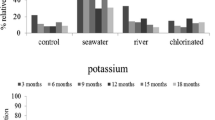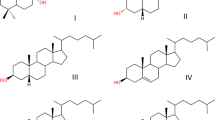Abstract
Adipocere is a late-stage postmortem decomposition product that forms from the lipids present in soft tissue. Its formation in aquatic environments is typically related to the presence of a moist, warm, anaerobic environment, and the effect of decomposer microorganisms. The ideal temperature range for adipocere formation is considered to be 21-45°C and is correlated to the optimal conditions for bacterial growth and enzymatic release. However, adipocere formation has been reported in cooler aquatic environments at considerable depths. This study aimed to investigate the chemical process of adipocere formation in a cold freshwater environment in Lake Ontario, Canada. Porcine tissue was used as a human tissue analogue and submerged at two depths (i.e., 10 and 30 feet) in the trophogenic zone of the lake. Samples were collected at monthly postmortem submersion intervals and analysed using diffuse reflectance infrared Fourier transform spectroscopy to provide a qualitative profile of the lipid degradation and adipocere formation process. Early stage adipocere formation occurred rapidly in the cold water environment and proceeded to intermediate stage adipocere formation by the second month of submersion. However, further adipocere formation was inhibited in the third month of the study when temperatures approached the freezing point. The depth of submergence did not influence the chemical conversion process as similar stages of adipocere formation occurred at both depths investigated. The study demonstrated that adipocere can form rapidly, even on small amounts of soft tissue, which may be representative of dismembered or disarticulated limbs discovered in an aquatic environment.





Similar content being viewed by others
References
Kahana T, Almog J, Shmeltzer E, Spier Y, Hiss J (1999) Marine taphonomy: adipocere formation in a series of bodies recovered from a single shipwreck. J Forensic Sci 47:142–151
Yan F, McNally R, Kontanis EJ, Sadik OA (2001) Preliminary quantitative investigation of postmortem adipocere formation. J Forensic Sci 46:609–614
Fielder S, Graw M (2003) Decomposition of buried corpses, with special reference to the formation of adipocere. Naturwissenschaften 90:291–300
Forbes SL, Stuart BH, Dadour IR, Dent BB (2004) A preliminary investigation of the stages of adipocere formation. J Forensic Sci 49:566–574
Notter SJ, Stuart BH, Rowe R, Langlois N (2009) The initial changes of fat deposits during the decomposition of human and pig remains. J Forensic Sci 54:195–201
Dent BB, Forbes SL, Stuart BH (2004) Review of human decomposition process in soil. Environ Geol 45:576–585
O’Brien TG, Kuehner AC (2007) Waxing grave about adipocere: soft tissue change in an aquatic context. J Forensic Sci 52:294–301
Forbes SL, Stuart BH, Dent BB (2005) The effect of the burial environment on adipocere formation. Forensic Sci Int 154:24–34
Vane CH, Trick JK (2005) Evidence of adipocere in a burial pit from the foot and mouth epidemic of 1967 using gas chromatography—mass spectrometry. Forensic Sci Int 154:19–23
Nushida H, Adachi J, Takeuchi A, Asano M, Ueno Y (2008) Adipocere formation via hydrogenation of linoleic acid in a victim kept under dry concealment. Forensic Sci Int 175:160–165
Fiedler S, Buegger F, Klaubert B, Zipp K, Dohrmann R, Witteyer M, Zarei M, Graw M (2009) Adipocere withstands 1,600 years of fluctuating groundwater levels in soil. J Archaeol Sci 36:1328–1333
Gill-King H (1997) Chemical and ultrastructural aspects of decomposition. In: Haglund WD, Sorg MH (eds) Forensic taphonomy: the postmortem fate of human remains. CRC Press, Florida, pp 93–108
Wilson AS, Janaway RC, Holland AD, Dodson HI, Baran E, Pollard AM, Tobin DJ (2007) Modelling the buried human body environment in upland climes using three contrasting field sites. Forensic Sci Int 169:6–18
Mant AK, Furbank R (1957) Adipocere—a review. J Forensic Med 4:18–35
Cotton GE, Aufderheide AC, Goldschmidt VG (1987) Preservation of human tissue immersed for five years in fresh water of known temperature. J Forensic Sci 32:1125–1130
Mellen PFM, Lowry MA, Micozzi MS (1993) Experimental observations on adipocere formation. J Forensic Sci 38:91–93
Sledzik PS, Micozzi MS (1997) Autopsied, embalmed, and preserved human remains: distinguishing features in forensic and historic contexts. In: Haglund WD, Sorg MH (eds) Forensic taphonomy: the postmortem fate of human remains. CRC Press, Florida, pp 483–496
Dumser TK, Turkay M (2008) Postmortem changes of human bodies on the Bathyal Sea floor—two cases of aircraft accidents above the open sea. J Forensic Sci 53:1049–1052
Stuart BH, Forbes S, Dent BB, Hodgson G (2000) Studies of adipocere using diffuse reflectance infrared spectroscopy. Vib Spectrosc 24:233–242
Stuart BH, Craft L, Forbes SL, Dent BB (2005) Studies of adipocere using attenuated total reflectance infrared spectroscopy. Forensic Sci Med Pathol 1:197–201
Notter SJ, Stuart BH, Dent BB, Keegan J (2008) Solid-phase extraction in combination with GC/MS for the quantification of free fatty acids in adipocere. Eur J Lipid Sci Tech 110:73–80
Parks Canada (2006) http://www.pc.gc.ca/progs/amnc-nmca/systemplan/itm4-/gla6_e.asp Accessed 23 Jan 2009
Environment Canada (2008) http://www.climate.weatheroffice.ec.gc.ca/climateData/canada_e.html Accessed 23 Jan 2009
Anderson GS, Hobischak NR (2004) Decomposition of carrion in the marine environment in British Columbia, Canada. Int J Leg Med 118:206–209
Acknowledgements
The authors wish to acknowledge the assistance of the Toronto Police Service Marine Unit in setting up the experiment, conducting weekly observations and measurements, and collecting the samples.
Author information
Authors and Affiliations
Corresponding author
Rights and permissions
About this article
Cite this article
Forbes, S.L., Wilson, M.E.A. & Stuart, B.H. Examination of adipocere formation in a cold water environment. Int J Legal Med 125, 643–650 (2011). https://doi.org/10.1007/s00414-010-0460-6
Received:
Accepted:
Published:
Issue Date:
DOI: https://doi.org/10.1007/s00414-010-0460-6




